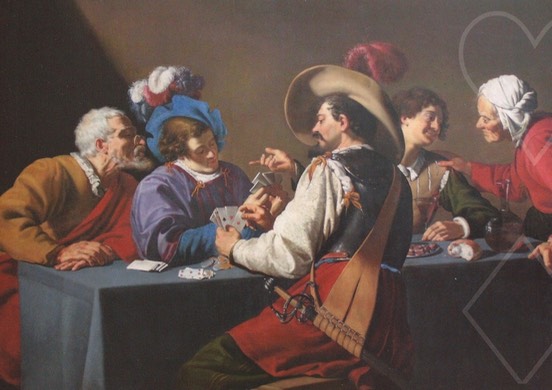
Last week, I received a copy of a recently published book, “Bridgers kunnen niet Bridgen” (in Dutch, I guess the best translation is “Bridge Players cannot play Bridge”) by Frans Schiereck. Picture on the right from the cover of the book.
The older readers will remember the author from early 1980’s, when he wrote a monthly column on junior bridge in the magazine of the NBB.
The book is about a rather unusual theme in the literature: the mistakes made at the table, in particular those bids and plays that any expert will immediately recognize as being totally wrong, but which are still made week after week by lower ranking players. And why, well, basically because nobody ever told them that they are wrong: chinese finesses, ruffing in the wrong hand, not covering honnors when they should (or the other way around), you name it.
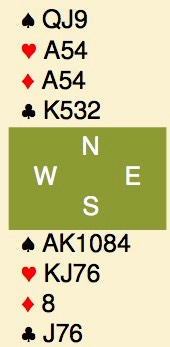
A typical example from the chapter on drawing trumps: south is in 4♠ on a ♣4 lead, to the ♣2, ♣A and ♣6. East returns the ♦Q to the ace. South has read something somewhere about ruffing losers, so he proceeds with the ♦4 ruffed in hand, then the ♥A and another diamond ruff.
And if you do this, and trumps split 3-2 with the ♥Q onside, declarer will even get away with it. 11 tricks, average score, next board.
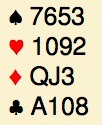
Of course, next time, east has this hand and declarer finishes down 1. “A good contract, partner, too bad the trumps broke 4-1, I’d have made if the the trumps split”. Nonsense, of course, but if nobody ever tells him where he went wrong, he’ll never find out.
In the book, Frans discusses 40 of those themes. The style can best be described as informal mixed with a lot of (dry) humor. It is as if a (good) teacher has been showing hands and examples on the whiteboard to his students, and somebody in the back took notes. The author nicely shows what differences one or two cards make. Compare:
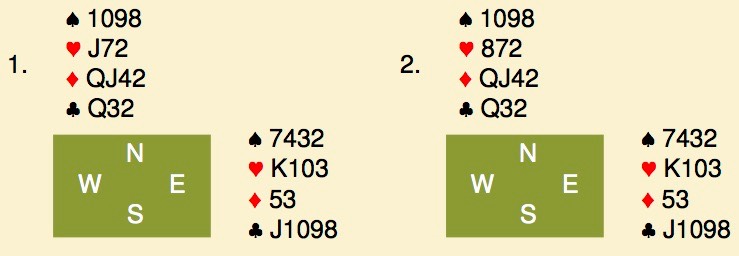
2NT-3NT, partner leads the ♥5, attitude. Declarer plays the ♥2 and you contribute the ♥?
Again, an expert will play the ♥10 and ♥K respectively in his sleep, but now turn to the poor beginner who has been taught “3rd hand high”. Frans nicely explains that on the first hand, one should play the ♥10, playing the ♥K is wrong if declarer has the ♥A as this will set up a second heart trick for declarer, if declarer has the ♥Qx(…) it doesn’t matter what he does. On the second hand, you should play the ♥K, which is the right card regardless whether declarer has the ♥Axx, ♥Qxx or ♥AQ.
So far, sound advice. What I’m less enthusiastic about, is the discussion of conventions. Frans mentions quite a few of them and with the limited space (100-odd pages), the discussion must be short.  Too short, for example in the section cuebids, this auction is shown with the explanation “Do you have a ♥-stopper”. Well, that is quite a short-cut on what 2♥ would show in standard practice and presented as such, I doubt that anybody will be able to figure out when 2♥ is the correct bid.
Too short, for example in the section cuebids, this auction is shown with the explanation “Do you have a ♥-stopper”. Well, that is quite a short-cut on what 2♥ would show in standard practice and presented as such, I doubt that anybody will be able to figure out when 2♥ is the correct bid.
Finally, I think the book could have done with a bit of editing and fact checking. For example, many times world champion Mr. Muller writes his name BAuke and not BOuke. 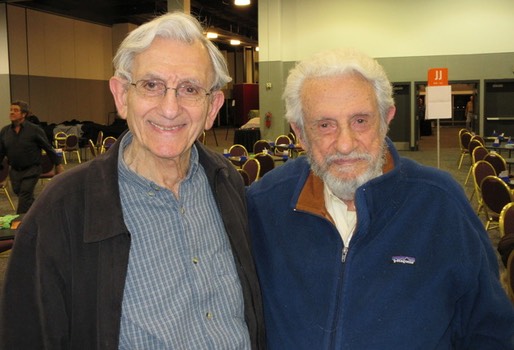 Another famous bridge player, Benito Garozzo, is quoted to have said something before he passed away, whereas last time I checked, he was still alive and at age 89 still winning. Picture on the left, from the Kansas City Nationals last month, Garozzo on the left after winning the senior pairs with Simon Kantor (92). More serious are the small errors in the cards, in the first hand above, the clubs in dummy suddenly change from ♣K532 to ♣K432 between diagrams, and is east said to lead the ♦8 where he doesn’t have that card. One can usually figure out what is meant, but a good editor would have fixed those errors, making the book easier to read for the target audience.
Another famous bridge player, Benito Garozzo, is quoted to have said something before he passed away, whereas last time I checked, he was still alive and at age 89 still winning. Picture on the left, from the Kansas City Nationals last month, Garozzo on the left after winning the senior pairs with Simon Kantor (92). More serious are the small errors in the cards, in the first hand above, the clubs in dummy suddenly change from ♣K532 to ♣K432 between diagrams, and is east said to lead the ♦8 where he doesn’t have that card. One can usually figure out what is meant, but a good editor would have fixed those errors, making the book easier to read for the target audience.
Bottom line: this is a good read for anybody who is not an expert, but who is serious about improving his game. Read the book slowly and take time to digest the contents. Also, focus on the sections on play and defence as they are much better than those on bidding.
If you are in the top 10% of the federation, read something else, you won’t learn much from it.
“Bridgers kunnen niet bridgen” has been privately published by Frans Schiereck, to order a copy, transfer €15.- plus €3.90 postage to his account NL04 INGB 0009 6229 30 and make sure that you include your address.
